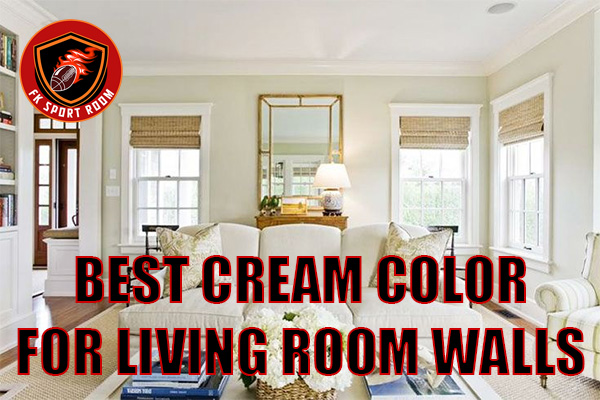Blogs
Best Cream Color for Living Room Walls: Warm, Timeless & Stylish
When it comes to choosing the perfect shade for your living room, cream is often a top contender. It’s versatile, timeless, and creates a warm, inviting atmosphere. Unlike stark white, cream tones bring softness to your walls, making your space feel cozy yet elegant. But with so many shades available, which is the best cream color for living room walls?
In this guide, we’ll explore the most popular cream paint options, their pros and cons, and practical styling tips with furniture, lighting, and rugs. Whether your home leans modern, classic, or bohemian, cream walls can set the perfect backdrop.

Why choose cream for living room walls?
Cream is a color that bridges the gap between white and beige. It’s fresh but not cold, neutral but not boring. Homeowners love cream walls because they:
- Brighten the room without looking sterile.
- Pair well with any décor style – from minimalism to traditional.
- Enhance natural light, making spaces feel more open.
- Provide a timeless look that doesn’t go out of style.
The best cream colors for living room walls
Here are some of the most popular cream shades, with styling tips to make them shine.
1. Warm cream
A warm cream leans slightly toward yellow or beige, creating a cozy and welcoming feel.
Pros:
- Makes the room feel warm and inviting.
- Works well in north-facing rooms that need extra light.
- Complements natural wood tones beautifully.
Cons:
- Can appear too yellow in certain lighting.
- May feel heavy in small, dim spaces.
Styling tips:
- Pair with dark wood furniture for contrast.
- Use soft white or amber lighting to highlight its warmth.
- Add patterned rugs in earthy tones (terracotta, rust, olive green) to ground the space.
2. Neutral cream
Neutral cream sits perfectly in the middle—not too warm, not too cool. It’s one of the most versatile paint options.
Pros:
- Universally flattering and easy to style.
- Works with both modern and traditional designs.
- Doesn’t shift dramatically under different lighting conditions.
Cons:
- May feel “safe” or too simple without strong accents.
- Can look flat if not paired with textures.
Styling tips:
- Combine with gray or taupe furniture for a sophisticated vibe.
- Use metallic accents (brass lamps, gold mirrors) to add dimension.
- Layer with plush rugs in neutral or geometric patterns for visual interest.
3. Cool cream
Cool cream leans slightly toward gray, offering a fresher, more modern take on this classic shade.
Pros:
- Perfect for contemporary or minimalist spaces.
- Enhances natural light without looking too stark.
- Works well with cool-toned accent colors (blue, gray, black).
Cons:
- May feel too cold in poorly lit rooms.
- Doesn’t pair as well with warm wood tones.
Styling tips:
- Style with sleek furniture in black, navy, or charcoal.
- Add warmth with soft textiles like wool throws or velvet cushions.
- Choose layered rugs—a neutral base with a textured top rug—to balance the cool tone.
4. Beige-cream blend
A cream with beige undertones is ideal for creating depth while keeping a light, airy vibe.
Pros:
- Richer and warmer than standard cream.
- Hides scuffs and marks better than lighter shades.
- Great transitional color between white and darker walls.
Cons:
- May feel more traditional than modern.
- Doesn’t always pair well with very bright colors.
Styling Tips:
- Pair with leather furniture (tan or caramel tones).
- Add bronze or copper lighting fixtures for warmth.
- Anchor the room with a neutral wool rug or jute rug.
5. Off-white with cream undertones
If you want the freshness of white but with a subtle softness, off-white with cream undertones is the way to go.
Pros:
- Feels crisp yet cozy.
- Maximizes light in small or dark living rooms.
- Offers flexibility with any accent color.
Cons:
- May appear just “white” depending on the light.
- Requires careful styling to avoid looking plain.
Styling tips:
- Layer with colorful furniture (navy, emerald, blush pink) to add personality.
- Use modern light fixtures in matte black or gold for contrast.
- Ground the look with a bold rug—geometrics or rich tones work beautifully.
How to style cream walls with furniture, rugs & lighting
The beauty of cream walls lies in their versatility, but styling makes all the difference.
Furniture pairing
- Warm cream walls: pair with rustic or wooden furniture.
- Cool cream walls: pair with sleek, modern pieces in black or gray.
- Neutral cream walls: balance with either soft pastels or bold jewel tones.
Rugs
- For cozy vibes: thick wool or shag rugs in neutrals.
- For modern looks: flatweave or geometric rugs in bold patterns.
- For natural charm: jute or sisal rugs layered with a patterned top rug.
Lighting
- Warm cream walls shine under soft amber lighting (lamps, sconces).
- Cool cream walls benefit from bright white LED lighting for crispness.
- Neutral cream walls adapt well to mixed lighting sources for flexibility.
Pros and cons of using cream on living room walls
Pros:
- Timeless and versatile.
- Works in both large and small living rooms.
- Enhances light and creates a cozy ambiance.
- Easy to pair with different design styles.
Cons:
- May feel too “safe” without bold accents.
- Some shades can look yellow or flat depending on lighting.
- Requires careful furniture and rug choices to avoid a bland look.
FAQs: Cream colors for living rooms
1. What is the most relaxing color for a living room?
Soft neutrals like cream, beige, and light gray, along with calming shades of blue and green, are considered the most relaxing.
2. Does cream paint make a living room look bigger?
Yes! Light cream shades reflect natural light, making the room appear more spacious and airy.
3. How do I prevent cream walls from looking yellow?
Choose creams with neutral or gray undertones, and test swatches in your room’s lighting before committing.
4. Can I mix cream walls with white trim?
Absolutely. White trim adds crisp contrast to cream walls, creating a polished and elegant finish.
Conclusion
Choosing the best cream color for living room walls depends on your space, lighting, and personal style. Warm creams create coziness, cool creams add freshness, and neutral creams strike a balance. With the right furniture, lighting, and rugs, cream walls can transform your living room into a timeless haven that feels both stylish and inviting.
Whether you prefer modern elegance or classic charm, cream is a wall color that adapts beautifully to your vision.
